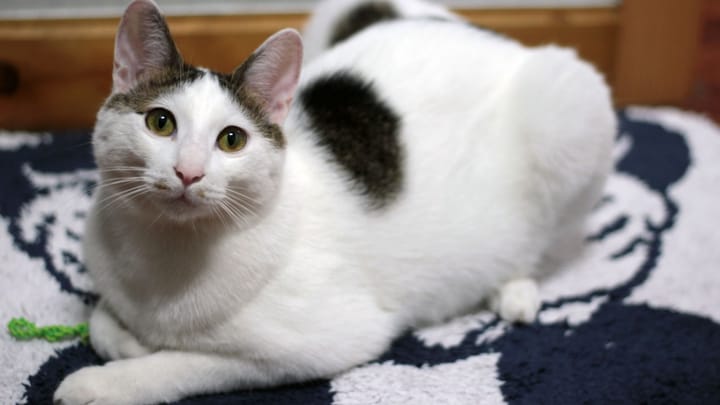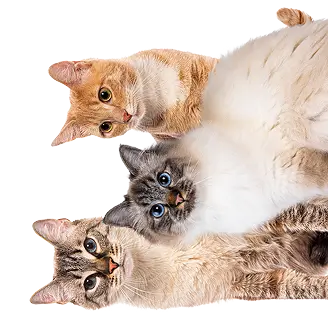Japanese Bobtail

The name Bobtail comes from "bobbed tail" which means "shortened tail" . The Japanese Bobtail is exactly what you would expect: a Japanese cat with a tail that is naturally shorter than that of a standard domestic cat. Not only is it shorter, but it also folds over to form a tassel on the cat’s lower back, which is so unique to its owner that it can be treated like a fingerprint! They are very rare in Europe, but they deserve recognition: with their unusual tails and their cheerful, energetic and endearing personalities, it is unsurprising that they have become a symbol of good luck in the Land of the rising sun!
|
Life expectancy |
The Japanese Bobtail has a life expectancy of between 14 and 16 years |
|
Temperament |
|
|
Adult size |
Female
Between 12 and 14 in
Male
Between 12 and 14 in
|
|
Adult weight |
Female
Between 4 and 9 lb
Male
Between 7 and 11 lb
|
|
Coat colour
Black / blue / grey-slate, red, cream, white |
Black White Red Cream Blue |
|
Type of coat
Short for shorthairs and mid length for longhairs. |
Short Long |
|
Eye colour
Blue, green, yellow / golden, odd |
Blue
Green
Yellow
Odd-eyed
|
|
Purchase price |
The Japanese Bobtail costs between £460 and £770 |
Japanese Bobtails are an integral part of Japanese culture and folklore. "Ordinary" cats often represent cleverness but, when they only have a small tail, they become auspicious to the Japanese! The Maneki-Neko statue perfectly illustrates this concept: literally meaning "inviting cat", this is a statue of very short-tailed cat, sitting, with its paw raised near its ear. This is supposed to bring happiness and fortune to where it is installed and thus they’re in almost all the houses and shops in Japan. Maneki-Neko is, of course, a Japanese Bobtail!
Hello Kitty is also a representation of a Japanese Bobtail!
More details about the Japanese Bobtail
Japanese Bobtail: Origins and history
There are many legends regarding cats in Japan, but it seems that the first cats came from mainland Asia, possibly from China or Korea. No one knows exactly when the genetic mutation responsible for the chrysanthemum tail occurred, but since it is present throughout Asia, it potentially existed prior to its arrival in Japan. The mutation is a dominant gene: thus when it is transmitted to the kitten, it forms automatically. The pompom tail spread very quickly in Japanese cats, as the country is a set of islands, and are therefore quite isolated.
The first Japanese Bobtails were given to the Emperor of Japan over 1000 years ago. He loved them so much that he considered them aristocrats and members of the court and the little cats were treated as such. However, in the 1600s, the sale and purchase of cats became illegal and the authorities demanded that all cats were released into the wild to be free. Why did they do this? Silk production was threatened by vermin that ate the worms and their cocoons. As natural hunters of this vermin, the cats were a desperate measure to protect the silk industry in Japan. However, as a result of this, Bobtails became alley cats in Japan.
They are an entirely natural breed and are in fact one of the oldest still in existence. In 1968, the first specimens were imported to the United States where breeders Judy Crawford and Elizabeth Freret worked on getting them recognised by the various feline associations.
Physical characteristics of the Japanese Bobtail
The Japanese Bobtail’s tail is undoubtedly its most differentiating characteristic. Consisting of one or more ‘welded’ vertebrae, it can be folded on itself in any way, unique to each individual. The overall length of the tail is variable, but in general at its longest extension, the tip should be no more than 3 inches away from its body. This results in a pompom with long hairs spouting out in all directions (even on the short-haired variety). Poetically, they have been compared to chrysanthemum flowers that grow in Japan.
Japanese Bobtails’ bodies are muscular but slender and delicate as they have a semi-foreign medium body type. They are well-proportioned, and even their truncated tails fit beautifully with the rest of their bodies. Their hind legs are slightly longer than their front ones, but are slightly bent (as if ready to pounce), meaning that their back is straight. Their head is an almost perfect equilateral triangle, with soft, curving lines and prominent cheekbones. Their ears, are large, and are placed at right angles to their heads. Their eyes form a pronounced angle when seen in profile, and are large and oval shaped.
The Japanese Bobtail has virtually no undercoat. Their soft, silky hair is attached to their bodies and makes them look like porcelain statues. Both long haired (Longhair Japanese Bobtail) and shorthaired (Shorthair Japanese Bobtail) varieties exist. The longhaired variety can have beautiful collars that complement their chrysanthemum-esque tails.
Japanese Bobtail: Characteristics
Japanese Bobtail: Behaviour
Breed compatibility Japanese Bobtail
Japanese Bobtail: Purchase price
It will be difficult and will take some time to find a Japanese Bobtail as it is a rare cat breed. On average, a Japanese Bobtail costs between £460 and £770. You must also expect to spend £25 per month to keep them in good health.
However, there are very few European breeders of Japanese Bobtails and therefore the price might fluctuate if they are imported from the USA, where they are more popular.
Japanese Bobtail: Shedding
Light
Shedding is minimal on these cats.
Japanese Bobtail: Grooming
Their lack of undercoat makes them very easy to maintain. A single weekly brush should be sufficient. Neither the short hair nor long hair varieties get knots in their hair thanks to its silky texture.
Japanese Bobtail: Health
They live 16 years on average.
Their lack of undercoat can make them sensitive to cold temperatures. However, their coat is reasonably waterproof and they adapt well to warmer climates.
The Japanese Bobtail has a slight tendency for obesity. Therefore you need to pay attention to their diet and exercise.
They don’t suffer from any particular genetic diseases. Obviously, they can develop all the same physical and oral diseases as all domestic cats, but they are generally a healthy breed. The dominant gene responsible for its unique tail is different to the Manx gene and thus is not associated with spinal abnormalities.
There is nothing in particular to report concerning their reproduction. They are only authorized to breed with other Japanese Bobtails, but Shorthair and Longhair individuals can mate together, as they are fundamentally the same breed.



